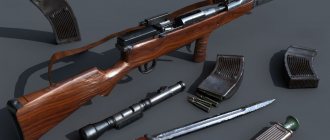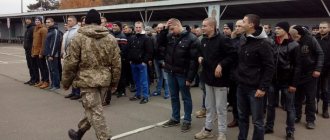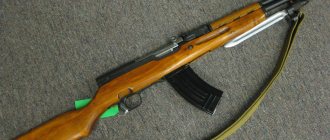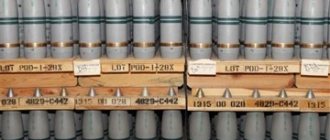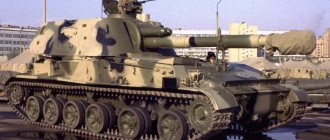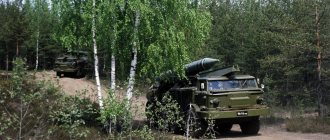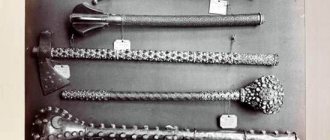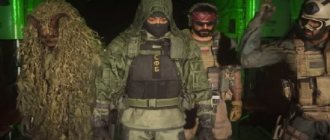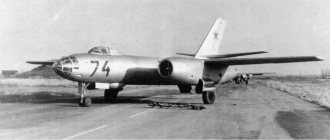Two soldiers: the appearance of a Red Army soldier in 1941 and 1945
The Great Patriotic War, which lasted four years, dramatically changed the Red Army, which, after the terrible defeats of 1941, by the spring of 1945 was able to turn the tide of events and win. However, the Soviet soldier not only gained experience, but also changed in appearance. The Warspot special project for the next anniversary of the Victory will help to understand exactly how the uniform and equipment of the Red Army soldier changed during the Great Patriotic War.
1941.
Steel helmet model 1936 (SSh-36)
. The first Soviet steel helmet, designated SSh-36, was created at the end of 1935. It was produced from 1936 to 1939. and since its creation has undergone several changes to the sub-tunnel device and methods of its attachment. Production unfolded with problems and was significantly behind schedule; in addition, the SSh-36 had shortcomings that gave impetus to further work to improve the shape of the helmet and search for a new alloy.
In total, about two million SSh-36 helmets were produced. These helmets were used by soldiers of the Red Army in Khasan and Khalkhin Gol, a number were sent to Republican Spain, all infantrymen had them during the Polish campaign, and were widely used in the Soviet-Finnish war. By the beginning of the Great Patriotic War, the SSh-36 was in large quantities in the army and was one of the main types. Some examples can also be seen in photographs from 1945 - many SSh-36s survived in the Far East at the start of the war with Japan.
Soldier's trousers, model 1935
. Accepted for supply to the Red Army by the same order as the 1935 tunic, the trousers remained unchanged throughout the Great Patriotic War. They were high-waisted breeches that fit well at the waist, loose at the top and tight around the calves.
Strings were sewn along the bottom of the trousers. There were two deep pockets on the sides of the trousers, and another pocket with a flap fastened with a button was located in the back. At the belt, next to the codpiece, there was a small pocket for a mortal medallion. Pentagonal reinforcement pads were sewn onto the knees. The belt had loops for a trouser belt, although the possibility of adjusting the volume was also provided using a strap with a buckle at the back. Bloomers were made from a special double “harem” diagonal and were quite durable.
Boots with wraps.
Boots with wraps first appeared in the Russian Imperial Army due to the shoe crisis in early 1915, when an acute shortage of boots was discovered. Boots with cloth wrappings were best suited for a mass army, since less leather was needed to make them and they were cheaper. After going through the Civil War, boots with windings ended up in the Red Army, where they were used in infantry units along with boots. Technical units, cavalrymen, and tank crews were only given boots.
The windings of black, gray or green protective color were a fabric tape usually 10 centimeters wide and about 2.5 meters long. The end of the winding was folded and stitched in the form of a triangle, into the top of which a lace or braid was sewn. Winding windings required a certain skill - as, indeed, did wrapping a footcloth around a leg. The windings were stored rolled into a roll, with the lace inside. The soldier wound the winding from bottom to top; the first turns were made the tightest and covered the upper part of the boot, the last ones almost reached the knee. The lace was tied at the top, hidden under the top turn and did not allow the winding to unwind. Boots with windings walked on the feet of the infantry until the victorious 1945.
Soldier's tunic, model 1935
. It was accepted for supply in the Red Army to replace the earlier tunic of the 1931 model. It was made of cotton melange fabric, fastened with buttons hidden under the placket. There are two pockets on the chest, and elbow pads made of an additional layer of fabric on the elbows. The tunic had a turn-down collar, onto which buttonholes with piping were sewn according to the branch of service. The Red Army infantry had a crimson field of buttonholes and black piping. At the top of the buttonhole was attached the emblem of the military branch, introduced in July 1940 - a target with crossed rifles.
By decree of the Council of People's Commissars of January 18, 1941, protective buttonholes were introduced for wartime personnel of the Red Army, and on August 1, 1941, by order of the NKO, protective emblems and insignia were introduced. The same order abolished the wearing of colored buttonholes at the front and in marching units, but for a long time at the front, regular infantry units wore colored buttonholes and insignia that unmasked Red Army soldiers.
Satchel model 1939.
To replace the duffel bag in 1936, a backpack, structurally similar to the German one, was adopted to supply the Red Army. However, military operation revealed its certain inconvenience in use, so by the end of 1939 a new backpack appeared. At the front it had hooks for hooking onto cartridge bags, for which a metal quadrangular ring was sewn onto the latter. For fastening to a waist belt when carried on a soldier’s back, a strap with a hook was provided at the bottom of the backpack. In addition, there were two more straps running from the shoulder straps to the bottom of the pack, one of which could be quickly dropped. These straps were used to adjust the backpack according to height.
The backpack carried linen, a towel, spare foot wraps, hygiene and clothing repair items, a pot with a mug and a spoon, gun accessories, and a set of groceries. The raincoat and its accessories were attached to the bottom, and an overcoat roll was attached around the perimeter of the backpack. In the traveling position, a helmet was also attached to the backpack. On January 31, 1941, by order of the NPO of the USSR, along with a grocery bag for infantry soldiers, a lightweight backpack of the 1941 model was introduced, which was a redesigned version of the 1939 backpack. By June 22, the troops could see backpacks of all the listed models, as well as a duffel bag of the 1930 model.
7.62 mm rifle model 1891/30. Mosin systems
. This repeating five-shot rifle chambered for 7.62x54 mm was adopted by the Russian Imperial Army on April 16, 1891. The design was based on the development of Captain S.I. Mosin with changes and additions borrowed from the Belgian Nagant rifle, as well as modifications based on proposals from members of the commission responsible for choosing a rifle for the army, and other officers. The rifle turned out to be very successful and fought through the Russian-Japanese, World War I and Civil Wars.
In 1930, design changes were made to the design. The receiver, sights and bayonet mount have changed. Changes were not introduced immediately, and the final appearance of the rifle was model 1891/30. acquired in only in 1935–1936. Other changes were also tested - for example, a new blade bayonet instead of a needle one, or replacing the wood used in the production of the stock and butt with other materials.
Despite the Simonov ABC-36 automatic rifle adopted by the Red Army in 1936, and then the Tokarev SVT-38 and SVT-40 self-loading rifles, the simpler and cheaper Mosin rifle remained the main small arms of the Red Army infantry in 1941 and later. After the outbreak of the war, its production remained at a high level until 1945, with the constant introduction of various kinds of simplifications into the design.
1945.
Steel helmet SSH-40
. This helmet is a modernization of the SSh-39 helmet, accepted for supply to the Red Army in June 1939. The design of the SSh-39 eliminated the shortcomings of the previous SSh-36, but the operation of the SSh-39 during the Soviet-Finnish war of 1939–1940. revealed a significant drawback - it was impossible to wear a winter hat under it, and the standard woolen balaclava did not protect against severe frosts. Therefore, soldiers often broke out the SSh-39 under-the-shoulder device and wore a helmet over their hat without it.
As a result, in the new SSh-40 helmet, the under-helmet device was significantly different from the SSh-39, although the shape of the dome remained unchanged. Visually, the SSh-40 can be distinguished by six rivets around the circumference at the bottom of the helmet dome, while the SSh-39 has three rivets, and they are located at the top. The SSh-40 used an under-body device of three petals, to which shock absorber bags stuffed with industrial cotton wool were sewn on the reverse side. The petals were tightened with a cord, which made it possible to adjust the depth of the helmet on the head.
Production of the SSh-40 began at the beginning of 1941 in Lysva in the Urals, and a little later in Stalingrad, but by June 22, the troops had only a small number of these helmets. By the fall of 1942, helmets of this type were made only in Lysva. Gradually, the SSh-40 became the main type of helmet for the Red Army. It was produced in large quantities after the war, and was withdrawn from service relatively recently.
Yuft boots.
Initially, boots were the only footwear for the Russian soldier: boots with tapes were accepted for supply only at the beginning of 1915, when the army sharply increased in numbers and boots were no longer enough. Soldiers' boots were made from yuft leather and were supplied to all branches of the military in the Red Army.
In the mid-30s, tarpaulin was invented in the USSR - a material with a fabric base, onto which artificial sodium butadiene rubber was applied to imitate the texture of leather. With the beginning of the war, the problem of supplying the mobilized army with shoes became acute, and the “damn leather” came in handy - the Red Army soldiers’ boots became tarpaulin. By 1945, the typical Soviet infantryman was wearing kirzachi or boots with tapes, but experienced soldiers sought to get leather boots for themselves. The photo shows the infantryman wearing yuft boots, with leather soles and leather heels.
Duffel bag.
This piece of equipment, nicknamed “sidor” by the soldiers, was a simple bag with a strap and a rope tie at the neck. It first appeared in the Tsarist army in 1869 and, without significant changes, ended up in the Red Army. In 1930, a new standard was adopted that determined the appearance of the duffel bag - in accordance with it, it was now called the “Turkestan type duffel bag”, or duffel bag of the 1930 model.
The duffel bag had only one compartment, the top of which could be pulled together with a rope. A shoulder strap was sewn to the bottom of the bag, onto which two jumpers were placed, intended for fastening on the chest. On the other side of the shoulder strap, three rope loops were sewn to adjust the length. A wooden brake boss was sewn to the corner of the bag, to which the loop of the shoulder strap clung. The shoulder strap was folded into a “cow” knot, into the center of which the neck of the bag was threaded, after which the knot was tightened. In this form, the bag was put on and carried behind the fighter’s back.
In 1941, there was a change in the appearance of the duffel bag of the 1930 model: it became slightly smaller, the shoulder strap was narrower and received a lining inside on the shoulders, which required stitching. In 1942, a new simplification followed - the lining in the shoulder strap was abandoned, but the strap itself was made wider. The duffel bag was produced in this form until the end of the 40s. Taking into account the ease of manufacture, the duffel bag became the main means for carrying personal belongings of Red Army soldiers during the Great Patriotic War.
Sudaev submachine gun model 1943 (PPS-43).
Many experts consider it the best submachine gun of the Great Patriotic War. The PPS combined ease of manufacture and maintenance, as well as trouble-free operation compared to other models. When developing the teaching staff, it was taken into account that mass-produced weapons should also be produced at non-core enterprises with not the best machine equipment. The only parts of the PPS that required complex machining were the bolt and barrel; everything else was made by stamping, bending, riveting and welding.
The PPS was equipped with a box magazine for 35 rounds of 7.62×25 mm. Having a folding stock and a loaded weight of just over 3.5 kilograms, it was very popular with soldiers, especially tank crews, paratroopers and reconnaissance officers. Production of the first batches of PPS-42 began in 1942 in Moscow, then in besieged Leningrad. In 1943, based on the results of military tests and the deployment of production, a number of changes were made to the design. The resulting model was adopted as the Sudaev submachine gun model 1943, or PPS-43. After the end of the Great Patriotic War, it was produced in many countries, both the Warsaw Pact and Finland, Germany and Spain.
This is not about all the equipment of Soviet soldiers. You can see more here. Follow the link for an interactive image.
The interactive image shows two infantrymen of the Red Army - a Red Army soldier of the regular army on June 22, 1941 and a victorious sergeant on May 9, 1945. Even from the photo you can see how uniforms and equipment were simplified over time: something turned out to be too expensive to manufacture in wartime, something didn’t catch on, something the soldiers didn’t like and was removed from supply. On the contrary, individual elements of equipment were spied on by the enemy or taken as trophies.
Not everything in the placement of equipment in the photo is done according to the regulations and instructions: for example, a 1941 soldier wears a 1939 model backpack, but his raincoat is not tucked inside the backpack. The 1945 soldier carries only one magazine bag for his submachine gun, although he was supposed to have two. However, in reality, the soldiers of the periods described often looked exactly like this.
In order to get information about each piece of equipment of a Red Army soldier, hover your cursor over the red markers in the image and click on them.
Mauser rifle: prototype and development
Hitler was a conservative. He went through the First World War, and although some of his biographers hint at the rather curious circumstances of his receiving the Iron Cross, the future “Führer of the German people” still had to fight. He did not really trust rapid-firing compact weapons and considered Mauser the best gunsmith designer in the world, who managed to create an unsurpassed model. Therefore, the German rifles of World War II were practically the same ones that the soldiers of Germany and Austria-Hungary fought with in 1914-1918, with minor design changes. Its prototype was the Gew.71, developed by the brothers Wilhelm and Peter-Paul Mauser, as is clear from the index, in 1871. Then new, improved models appeared (“88”, “89”, “92” and “94”), taking into account proposals for improving characteristics coming from the military. Ultimately, all these changes were reflected in the final Mausers of '71. These were the most popular German rifles of World War II.
History of the Mosin three-line
Stalin thought more progressively, which produced results. The number of machine guns produced in the USSR was 6 times greater than in Nazi Germany (six million versus one). But this does not mean that no attention was paid to traditional small arms. New models were being developed, they were tested in combat conditions (and there were plenty of them: Khalkhin Gol, the Karelian Isthmus), and their advantages and disadvantages were determined. But, oddly enough, the best weapon of the Red Army soldier remained the three-line Mosin, created under the Tsar. It was reliable, easy to manufacture and was distinguished by a happy combination of excellent tactical and technical data with ease of handling.
It has its own history, dating back to the sixties of the last century. At that time, the Russian army needed new small arms, and this problem was initially solved haphazardly. Then, in 1892, a competition was announced, in which many willingly took part, in search of profitable and large orders, the Danish Krag-Jorgensen, the Belgian Nagan. The Russian gunsmith S.I. Mosin did not stand aside either. Ultimately, the domestic model won, although the author had to make a number of changes to its design, borrowing them from competitors.
German Mauser carbine
The design ideas of gunsmiths of the late 19th century worked in approximately the same direction. A review of the Gew.98 rifle will not reveal any particular revolutionary daring. The only difference is that the lever safety design is novel, and the five-cartridge magazine is compact in size, due to the double-row arrangement of ammunition. By the way, it was proposed to increase the clip capacity to seven or even ten charges, but the German General Staff decided that five would be enough. The Mauser brothers created their own cartridge, taking care of the sale of “consumables”, and also improving their characteristics (its size is 7.92 x 57). The sight is slatted, with an intended range of up to 2 km. And, of course, a cleaver-shaped bayonet, although other types were also proposed.
As for the name “carabiner,” it changed practically nothing except the method of attaching the belt.
Mosin design
The design characteristics of the Mosin rifle as a whole differ little from the description of the German analogue. The three-line caliber (0.3'') was the Russian standard, the barrel was long (more than a hundred calibers). The magazine is box-shaped and integral, its capacity is four rounds. Reloading is carried out manually, the bolt is of a longitudinally sliding type. The safety is very simple and original in Russian: to avoid an accidental shot, you had to pull the trigger and turn it slightly around its axis, after which the firing pin could no longer hit the primer. The sight had slightly greater calibration accuracy due to its two possible positions. The step of each scale is 200 meters.
The bayonet with which Soviet rifles of the Second World War were equipped deserves special words. It was tetrahedral with a flat point (it could be used as a tool during disassembly). He was terrible: the edges of the wound he inflicted immediately converged, and internal hemorrhage occurred. The Russian faceted bayonet was subsequently banned by international conventions.
After 1939, the troops received modernized Mosin rifles, which differed from the prototype in some design features, however, minor ones. The stock rings and methods of fixing the bayonet and ramrod were changed, and the sight graduations were made metric.
Weapons of Soviet snipers...
There is a category of small arms, during the development of which all the usual characteristics of mass-produced models fade into the background. The main goal of the designer is to ensure the shooter’s ability to hit the target from a long distance. Accuracy is most important. Soviet sniper rifles of World War II were produced in two main systems. In 1931, the same Mosin three-ruler, with a slightly modified bolt handle, and made with special quality, received an optical sight. Externally, it differed from the original design in that the bolt stem was directed downward, and not upward, as on the prototype.
Soviet World War II sniper rifles SVT-40 are described above. It only remains to add that during their manufacture the greatest precision of metalworking was demonstrated and, of course, a bracket for optics was structurally provided.
Semi-automatic AVT-40
The production of an assault rifle was more expensive than a rifle. Before the war and at its beginning, this was of great importance, so Tokarev created something in between and, as it seemed, optimal. A fighter armed with an AVT-40 rifle could fire single shots and bursts. The magazine held ten rounds. However, it soon became clear that the receiver could not withstand prolonged shock loads, and automatic shooting was banned. The main advantage of the sample turned out to be useless, and in all other respects the sample was inferior to the Mosin rifle.
Self-loading system Tokarev SVT-38
The design of the Tokarev SVT-38 corresponded to the concept of a self-loading rifle rather than an automatic rifle. Compared to the ABC-36, it had a longer sighting range and improved ease of maintenance, but, unfortunately, it turned out to be too bulky and capricious. These shortcomings especially manifested themselves during the Winter War, when failures became more frequent in low temperatures. However, despite the fact that the model was discontinued back in 1940, the Tokarev SVT-38 served during the years of the fight against the fascist invasion. They were used mainly when accuracy was more important than reliability.
The next design of Tokarev SVT-40
The design flaws of the SVT-38 were partially eliminated in the next model of 1940. Designers fought against bulkiness and excess weight by drilling holes and deepening chamfers wherever possible. The SVT-40 became even lighter than the three-line, but was inferior to it in the main quality most valued by soldiers - reliability. In addition, the poor technical training of the personnel of most of the Red Army prevented the competent maintenance of this rather complex weapon. Accuracy was also poor. But the SVT-40 found its application in special units designed for precise fire. It didn't make the best sniper rifle, but it was quite decent. Each “barrel” has its own disposition and character, and if the shooter was talented, he soon got used to his weapon, adapted to it and achieved excellent results.
In other countries
Not only in the two main warring countries, but throughout the rest of the world, the attitude towards automatic types (at that time mainly submachine guns) was wary. Rearmament required a huge investment of funds, and no one could predict the result. The accuracy and reliability of the new models were questionable; development and testing required an increase in defense budgets. In addition, it was clear to everyone that the already considerable load carried by a soldier would become even greater, since you couldn’t find enough cartridges for all these machine guns. The most popular rifles of the Second World War were produced, in addition to the USSR and Germany, in the USA (Springfield and Garand), in Britain (Lee Enfield), in Italy (Mk I No. 4) and in Japan (Arisaka). . All of them had disadvantages and advantages, but in general they showed themselves to be quite equivalent. And the main rivals remained Soviet and German gunsmiths.

